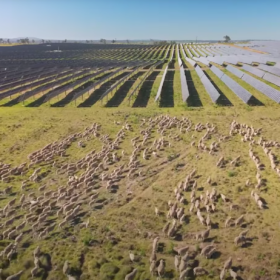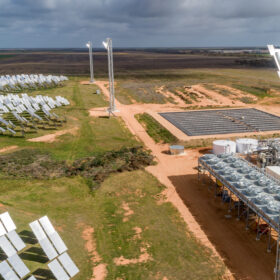From pv magazine Global
Canadian Solar’s e-Storage subsidiary has launched SolBank 3.0, the latest iteration of its utility-scale battery energy storage system. It said the new product offers up to 45% more capacity and a 40% decrease in commissioning time compared to the previous 2.0 iteration.
The 20-foot containerised battery system offers up to 2.35 MW of power and a capacity of 5 MWh. It features higher density energy cells, advanced safety systems, liquid cooling, and active balance controls.
SolBank 3.0 features lithium-ferro-phosphate cells and sports a 93% round-trip efficiency. It is offered in two-hour and four-hour duration configurations. The battery pack is IP-67 rated for safety.
The battery comes equipped with a pack and electrical redundancy protection system, abnormal performance detection, multi-level fire alarms, suppression protection, and more as part of its safety and controls system. An optimised thermal management system reduces auxiliary power consumption by up to 30% compared to the previous generation, said Canadian Solar.
“SolBank 3.0 features exceptional new elements like higher energy density cells and advanced safety design,” said Colin Parkin, president of e-Storage. “In addition, our e-STORAGE team also provides value-added services, such as system capacity maintenance and augmentations, operation and maintenance, and plant optimisation.”
In November, Canadian Solar reported $1.85 billion of revenue for the third quarter. Solar module shipments fell short of expectations at 8.3 GW. However, the company’s module shipments have increased 39% on a year-on-year basis.
Canadian Solar expects module demand to rise sharply in 2024, with shipments increasing roughly 50% year on year. But Roth Capital Partners said that this may be a bit optimistic as the company looks to clear excess inventory channels in Europe. It expects module demand to increase by only 10% to 15% in 2024, driven mostly by utility-scale demand, while residential solar demand could fall in 2024.
This content is protected by copyright and may not be reused. If you want to cooperate with us and would like to reuse some of our content, please contact: editors@pv-magazine.com.








By submitting this form you agree to pv magazine using your data for the purposes of publishing your comment.
Your personal data will only be disclosed or otherwise transmitted to third parties for the purposes of spam filtering or if this is necessary for technical maintenance of the website. Any other transfer to third parties will not take place unless this is justified on the basis of applicable data protection regulations or if pv magazine is legally obliged to do so.
You may revoke this consent at any time with effect for the future, in which case your personal data will be deleted immediately. Otherwise, your data will be deleted if pv magazine has processed your request or the purpose of data storage is fulfilled.
Further information on data privacy can be found in our Data Protection Policy.